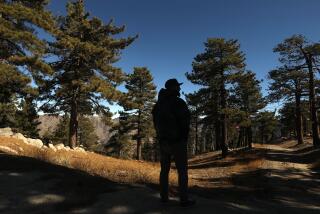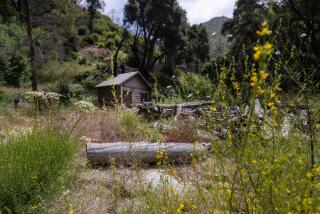Santa Monica Mountains Park May Face Cuts : Budget: The recreation area’s services could require temporary shutdown if Congress and President Clinton can’t agree on appropriations bill next month.
Drastic cuts in public access and park programs for the Santa Monica Mountains National Recreation Area could be imposed by the middle of November because of funding problems in Washington, according to park officials.
A contingency plan envisions layoffs of 65 employees, suspension of nature education programs, closure of the park’s visitor center and parking lots, and termination of ranger-led hikes through the area.
The cutbacks are to be implemented if Congress and President Clinton do not resolve differences on funding for the National Park Service and other federal programs. They would have gone into effect this week, but Congress passed an emergency funding bill for the next six weeks.
The contingency plan is on file at the National Park Service regional headquarters in San Francisco. Lists have already been compiled and the workers who would be put on furlough know who they are.
“Talk about the Grinch stealing Christmas,” said Deputy Supt. Scott Erickson of the recreation area. “We’re really concerned about our employees. Imagine not getting that paycheck every two weeks.”
Visitors at the Rancho Sierra Vista site just south of Thousand Oaks in the Santa Monica Mountains National Recreation Area last week were also distressed over the possible shutdown of park services.
“It’s disgusting that they would even consider doing such a thing,” said Nettie Klonsky, a 79-year-old Newbury Park resident who walks the sandy paths of the area almost daily, picking up litter as a public service.
She held out her arms, palms up, motioning to the hills around her. “What is America without this?”
Established by Congress in 1978, the recreation area stretches from Point Mugu State Park to Griffith Park in Los Angeles, encompassing 155,000 acres in Ventura and Los Angeles counties. The National Park Service owns and manages 22,000 acres within those boundaries that also encompass state and county parks and private holdings.
Programs in the Santa Monicas are among hundreds of national parks and other Interior Department programs that may have to be suspended if substantial differences cannot be worked out.
At issue is the Interior Department appropriations bill, which in its present form carries items that Clinton has promised to veto.
*
With no chance of agreement on the existing funding bill for fiscal year 1996, which begins Monday, Congress last week passed an emergency law to extend funding at 1995 levels for six weeks.
The intervening period is expected to provide enough time to work out differences and devise a funding package acceptable to Clinton. But that will take some work, said Melissa Kuckro, aide to Rep. Anthony Beilenson (D-Woodland Hills).
Clinton had requested $1.158 billion for the National Park Service operations, but the latest form of the bill allocates only $1.083 billion. The President asked for $180 million for park construction, but the bill contains only $143 million; and Clinton asked for $83 million for park land acquisition, but the bill contains only $49 million.
“And that’s not the worst of what he objects to,” Kuckro said. Other issues are policy changes that loosen restrictions on mining and logging, funding cuts in energy conservation programs, and a moratorium on new listings of endangered species.
Through the tangled process, however, the bill in its present form does contain some potentially good news for the Santa Monicas, Kuckro said.
The original bill allocated land acquisition money to each park individually, and none was earmarked for the Santa Monicas. But the present version of the bill hands the $49 million over to the Interior Department in one lump sum, for distribution as it sees fit.
“Within the Interior Department, there is strong support for the Santa Monicas,” Kuckro said. “We have a secretary [of the Interior] who sees the value of national parks and of a park that serves as large a number of people as the Santa Monica recreation area does. The Santa Monicas could potentially be eligible for some of those funds.”
Deputy Supt. Erickson said that recreation area officials have not requested any money for land acquisition under the present budget problems. But the recreation area hopes to be funded for up to $4 million to buy a nine-mile portion of the Backbone Trail that is now owned privately.
That portion of the popular trail travels the crest of the mountains near the Circle X Ranch. Erickson said another $1 million is needed to buy privately owned parcels surrounded by parkland.
*
But for now, he is more focused on the immediate task: keeping the park open.
If the contingency plan is implemented, the sites whose gates would be locked include the Rancho Sierra Vista area off Potrero Road, the Circle X Ranch campground high in the hills above Thousand Oaks and the Peter Strauss Ranch near Agoura, which is often used for weddings and large meetings.
The Paramount Ranch would remain open for filming of “Dr. Quinn, Medicine Woman,” but closed to the public, the frequent ranger-led tours explaining the history of the ranch suspended.
Also suspended would be the Parks as Classrooms program. Each year, October through May, the park offers five educational programs for schoolchildren every week. They include three classes a week in which the children come to the Satwiwa Native American Culture Center, at the Rancho Sierra Vista site, for a program on biodiversity, explaining the range of plants and animals found in the area.
Twice a week, rangers go into classrooms, teaching children about the cultural diversity of the Santa Monicas, including talks on how the Chumash lived, what life was like during the era of the Mexican ranchos, and present-day culture.
*
“This program is so well received by teachers, there is a two-year waiting list,” said Lorenza Fong, chief of interpretation for the Santa Monicas. Another program still in experimental stages called Parks as Laboratories is designed to teach middle-school students about land, water and air.
“The kids really like that one,” she said. “But we won’t be able to offer any interpretive programs unless we get a budget passed.”
Mountain bikers Andrew Wright and Steve Williams, both of Thousand Oaks, were out cruising the hills of the Santa Monicas last week.
Both were unhappy at the possibility that the trails would not be maintained and the gates to parking lots closed.
“When I was a student at UCLA, we came up here to ride,” said Wright, an environmental technician. “People come from all over to ride here.”
Williams, a flight instructor, called the idea “bogus.”
“This parking lot fills up on the weekends and if people have to park on the streets to get back here, the neighbors won’t like it,” he said.
Klonsky, who carried a bag of collected debris as she walked the trails, searched for words to describe how deeply she felt about the prospect of closing off access to the parks.
“It would be the most awful thing that ever happened,” she said. “Shouldn’t people be able to relax and see nature in full bloom?”
More to Read
Sign up for The Wild
We’ll help you find the best places to hike, bike and run, as well as the perfect silent spots for meditation and yoga.
You may occasionally receive promotional content from the Los Angeles Times.






